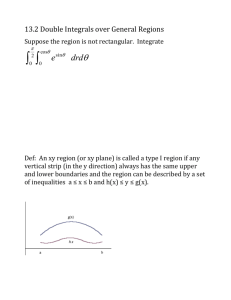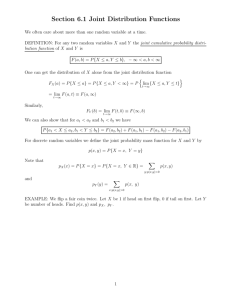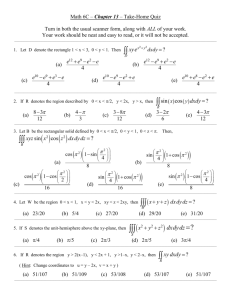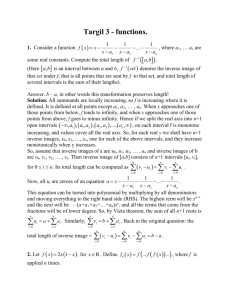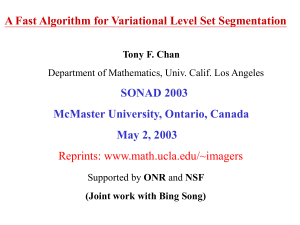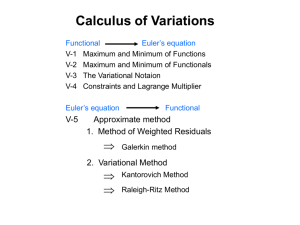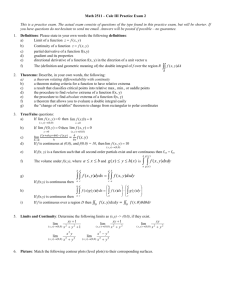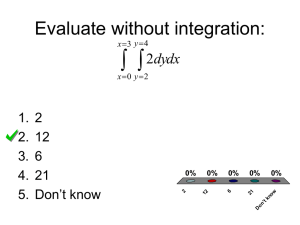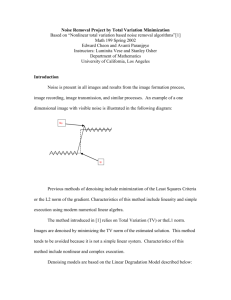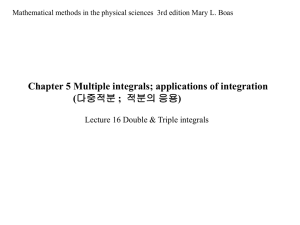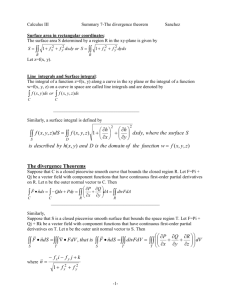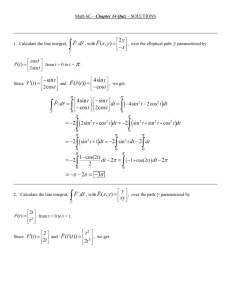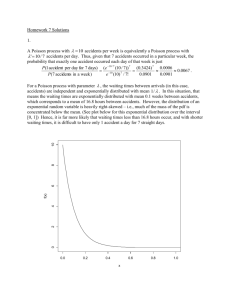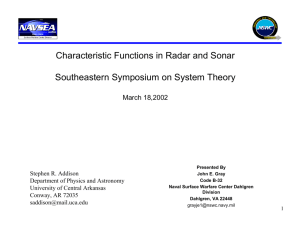Similarities in Irrationality Proofs for 7r, ln2, C(2), and C(3)
advertisement
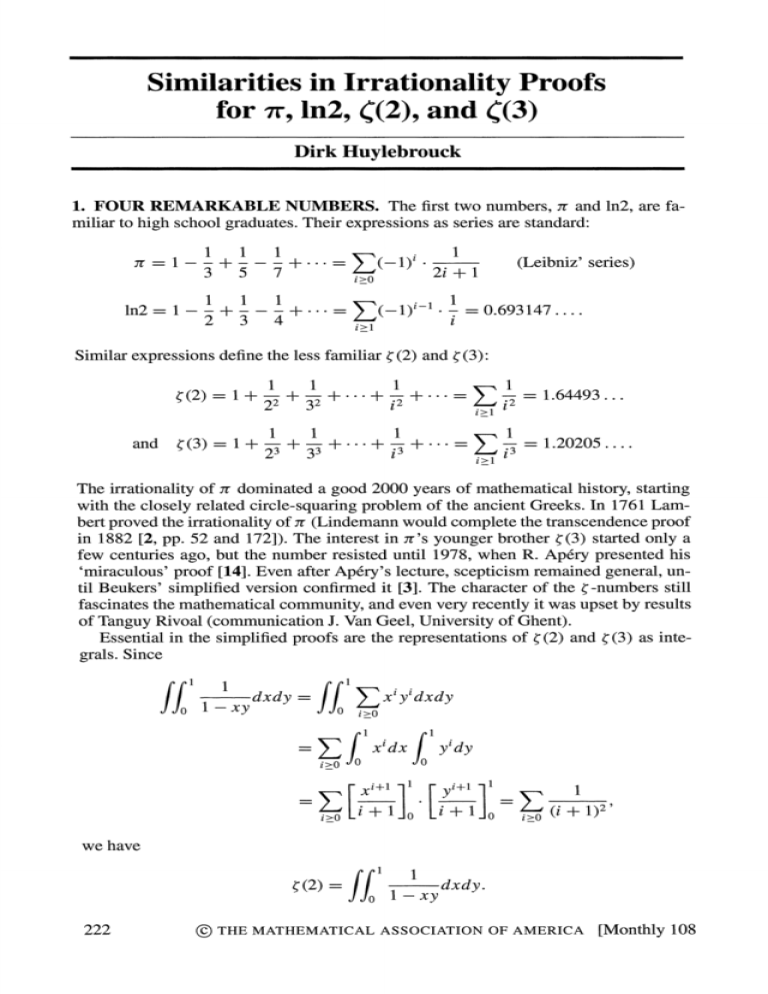
Similarities in Irrationality Proofs
for 7r,ln2, C(2),and C(3)
Dirk Huylebrouck
1. FOUR REMARKABLENUMBERS. The firsttwo numbers,wrandln2, are familiarto high school graduates.Theirexpressionsas seriesarestandard:
ST =
. 2i + 1
IiI>O-1)'
1-3 +357
ln2 = 1 -2
+ 3-4
2-l)
-+
+*=
(Leibniz'series)
=0.693147....
i>1
Similarexpressionsdefinethe less familiar( (2) and (3):
(2) = 1 + 2+
3 +
32
22
+
and ((3) = 1+ I+
33
23
+ i +
i
=E
j2
j2
i>1
+ j3i +
= 1.64493...
=
=
1.20205....
j
~~~~i>1
The irrationalityof 7rdominateda good 2000 years of mathematicalhistory,starting
with the closely relatedcircle-squaringproblemof the ancientGreeks.In 1761 Lamof 7r(Lindemannwouldcompletethe transcendenceproof
bertprovedthe irrationality
in 1882 [2, pp. 52 and 172]). The interestin ir's youngerbrother((3) startedonly a
few centuriesago, but the numberresisteduntil 1978, when R. Apery presentedhis
'miraculous'proof [14]. Even afterApery'slecture,scepticismremainedgeneral,until Beukers'simplifiedversionconfirmedit [3]. The characterof the (-numbersstill
fascinatesthe mathematicalcommunity,andeven veryrecentlyit was upsetby results
of TanguyRivoal(communication
J. VanGeel, Universityof Ghent).
of Q(2)and (3) as inteEssentialin the simplifiedproofsare the representations
grals.Since
J~dxdy
If'AX1
Ixy
=
If
AX
=E
Zxy'dxdy
>E
xidx
yidy
o
>E[i+1o[+
E
(i + 1)29
we have
Q(2)= f I
222
J-
dxdy.
?dTHlEMATHEMATICALASSOCIATION OF AMERICA [Monthly108
Similarlyfor <(3):
t
f
=21
x ylnxydxdy
=ffLxnxydxdy
xiln xdx f
=2E
xiyInxdxdy
yidy
i>o?o
2E
([xi+llnx]-
=2E i+1
(-i
Xi-+1dx)
i
d
f
+ 1) i+1
-2E
=
(i + l)3
-
2<(3)
Thus,
<(3) =I-
1
f
inxydxdy.
Incidentally,the integralfor <(2) can be evaluatedvery easily. This computationis
not reallyneededhere,butit providesan illustrationof a calculationinvolvinga zeta
expression.The easiest componentsof Apostol's,Beuker's,andKalman'sresultsare
combined,andexceptfor someelementaryknowledgeaboutdoubleintegrals,no other
prerequisitesseem needed: see [1], [3], [10]. The combinationprovidesa proof at
graduatelevel for Euler's<(2) result;see [4] for a morerigorousandgeneralproof.
First, rewritethe differenceof two integralsusing the substitutionX = x2 and
Y
=
y:
(I
ffl:
f'
(I
1
11(1
)dxdY=
ddxdy
-1
-
Y)
)
)dXdY.
(1)
dxdy.
(2)
Next, obtaintheirsum:
f' (iixy+
1 xy1+x
- 1
dxdy = 2
yo
lxy2
22
Adding(1) and(2) gives
2 ff
|
dxdy =
f1
1
dXdY + 2
2!dxdy,
2
or
1
+2
2<(2) = -2(2)
JJ l-X2y2
2
dxdy.
Thus,
31
-<(2) =
March20011]
dxdy.
223
Substitutingx = sin0/cosq5 and y = sinq/cos0 yields a Jacobian equal to
1 - tan20 tan24 andthis is the denominatorof the integrand.
(2)=-
3
d0f
?
?
1
2
(sinO
doj
o
tan2p) dy
C
cosO
kCosq0
=j
=3
2 (1-tan20
sinS
q2
dc~p=~~3 8 =6.
This is Euler'swell-knownresult:( (2) = 7r2/6.
2. FOUR PROOFS IN ONE. The Borweinscollectedirrationalityproofsfor these
four numbers[5, pp. 353, 366, 369, and 370], in a very rigoroustreatise.In orderto
maketheir similaritymore evident,we first summarisethe highlightsof the demonstrationsin generalterms.
Supposethe irrationalityof a numbert mustbe shown.In the fourcases we present
here,afamily of integrals(j E N) concerningthatnumberis proposed:
= Rj +Sj
X x'f(x)dx
whereRj and Sj E Q;f is an unknownfunction.
Now if t were a fractiona/b, this family of integralswould yield rationalexpressions f0'
xlf(x)dx = Cj/Dj, where Cj and Dj E Z. Integermultiplesof these integralsandtheirsumswouldagainexhibitthis property.Thus,if Pnj E Z andn E N:
n
In
j
E
PnjXf(x)dx
= EPnj
n
I
x'f(x)dx
f
E
Pnj Dj
=0
-
F'
with againEn and Fn E Z.
Applythis propertyto the Legendrepolynomials:
Pn(x) =
1 dn
=
! dXn (xn(1 -x)n)
PnjXj.
For example, Po(x) = 0, PI(x) = 1 - 2x, P2(x) = 2
-
12x
-
12x2. Note that
Pnj E Z.
Thus,for the given familyof integrals,
/Pn(x)f
(x)dx
-
Bn,
with An,BnE Z
The choice of Legendrepolynomialsis inspiredby the possibilityof performing
integrationsby partseasily. Indeed,since Pn(0) = 0 = Pn(1), and similarlyfor the
derivativesof xn(1- x)n up to the ordern, manytermscan be simplified:
P (x)
224
f (x)dx
(X n(l
-
x))
f(x)dx
THE MATHEMATICAL
ASSOCIATION OF AMERICA
n
[Monthly108
[n! d;n-1 (x (1 -x))
=
Oj
t
n!dXn
nl(X
1 1d
f 1Xn(-x)nd
dx
nJ
Integratingby partsn timesleadsto
f(x)]
dx dx.
(1X))
X)n
t(Xn
f(x)df(x
dx.
dXn-d
~
~
a
In the fourencounteredcases the functionf(x) happensto be suchthat
(l-x)n
jAxn
d
x)
dx
|=
fX
(g(x))nh(x)dx|
wherethe maximumvalueM of g(x) is smallenoughto ensurethat
-d0.
|B nM fh(x)dx
In addition,all the integralsfleP(x)f(x)dx arenon-zero,andthis immediatelyimplies the irrationalityof t:
O<IA
=
Bn]1
Pn(x)f(x)dx
<
B-M ]
h(x)dx
O.
a
is a positive integerso this is impossible;
cannotbe
Indeed,for any n E , al
rational.
Of course, the difficultyin the proofs lies in the appropriatechoice of f(x). It
must yield a family of non-zerointegralswhose membersare easily expressedas a
combinationrationalnumberandt. In addition,it shouldsimultaneouslybe possible
to maximizetheir productwith an integerthat becomes largerand larger,and still
ensurethe indicatedconvergenceto 0.
3-I. Irrationality of -7rTake f(x) = sin(wx). It is a standardcalculus exercise
1
to show that the membersof family of integralsof the form xJ sin(wx)dx are
polynomials in wrof degree at most j, divided by wi. The linear combinations
f0oPn(x)sin(wx)dx arenon-zero,andthus,if w were the rationalnumbera/b:
0 < An, = an j
=
n
an
Pn(x) sin(7rx)dx
J
!_xn(1
-
X)n
(sinrx)dx|
<
an
_Xn(I
-
x)n
ndx
since the n-th orderderivativeof sin(wx) is ?wr sin(wx) or ?rn cos(rx). The maximumvalueof x(I - x) is 1/4, attainedat x = 1/2. Thus,the finalexpressionis less
March2001]
225
than
(n
in1
ni
whichis arbitrarysmallfor largevaluesof n; see [13].
3-l1. Irrationalityof 1n2 The choice is f (x) = 1/(1 + x). An Euclidiandivisionof
xi by 1 + x allowsus to computethe familyof integrals
xj
1
=-
x_dx
1+x
1
-
]
-1I
F ?1 ln2.
+
If ln2 were a/b, then
0<
lAnl =
= (bdn)Jo
fX( -x)4
<
(1
(bdn)
(wheredn= LCM{1,2, 3, ...,n})
dx
(bdn) IPn(x)
[d+(1
I
)]dx
dx.
-x)\'
since the n-th orderderivativeof 1/(1 + x) is (-1) ... (-n)(1/(l + X))n+l Now on
[0, 1], themaximumvalueof x (1 -x)/( + x) is 3 -2
, achievedatx = -1 ?V+.
A roughinequalityfrom numbertheoryis dn = LCM{1, . . , n} c 3n. Finally,since
(3(3 - 2V) )n < 1, the irrationalityof ln2 is established;see [5, p. 370].
3-IIl. Irrationalityof ((2) The choice is
f(x)
=
f
l-Y)
dy
-xy
Eachmemberof the familyof integrals
[j
jl
1
0
(1IY)nd]d
I -xy
is a sumof integralsof the form
Y dydx, with r,
f
O
s EN.
-xy
Thesecan againbe computedthroughan Euclidiandivisionof xiyk by 1 - xy, which
gives a sumof integralsof the form
Jl
qdydx,
o
I
dYdx, 110-xy
_dydx
or
1
xy
dydx.
The latteris ( (2), while the othersaresumsof fractions,whichcanbe computedusing
partial integration for the integral f xmln xdx. Thus when r s,
226
?gTHE MATHEMATICAL
ASSOCIATION OF AMERICA
[Monthly108
J
ff
-dydx
1-x4y
is a sum of fractionswhose commondenominatoris the squareof least commonmultiple (LCM)of the firstn + 1 integers.Whenr = s, the integralequals
i >rji2
+2)
=r2-(+
Thus,
Pn(x)f(x)dx
f
-
d2A
wheredn+1is the LCMof the firstn + 1 naturalnumbersandAn E ZLO
Now
O<
10 Pn(x)f (x)dx
IAnI= dn2+1
=
2
= dn+1 I
= d2?1f
d
1 Xn(fl
Jo !
y(n
x .(1-.x).(-1)
(X(1
(-n)
x)y(xy))
[x
(I
(dy
)f
-_dydx
Xy)n-
(3)
- y)/(t -xy)
is ((-1 + V5)/2)5, and
On [0, 1], the maximum value of x(l -x)y(l
is attainedfor x = y = (-1 ? V)/2. Togetherwith dn+1< 3n+1, this showsthatthe
expression(3) is less than
(3n+1)2f
(
dxdy = 9 (
(2) < 1,
whichestablishesthe irrationalityof ( (2); see [3].
3-IV. Irrationalityof C(3) Take
1
f (x)
[(y)
lnxy dxdy.
The membersof the familyof integrals
[f
|1xJ
o
0
Pnf(Y) lnxy
dxdy dx
1-xy
arecomputedthroughthe derivativeof
March2001]
227
J
dd
Xr+tyS+t
1d-xy
withrespectto t, whichis
I
S+t
1 Xr+t
1
lnxydxdy.
-xY
If r 0 s, this is a sum of fractions since d(r + t)-m/dt =-m/(r
+ t)'1,
and the
LCMof the denominatorsis (dr+t)3.
When r = s, the result is
d
1
irt d1t(r+
i >r+t
-2
t)2
(r+ t)3
i>t
~
i>r+t
~
=-2 ((3)(1
+
(r
3
*+
+ (r +1l)3 +
+(r +
t)3)
Thus,
fPn (x)f (x)dx -Id A
3-
1
whereAn E Z anddn+lis the LCMof the firstn + 1 naturalnumbers.
Now
IAni = dn+1f
Pn(x)
= d3+1
= d3
=
3
f fl
Xf(l
fJl;
t }
-
1
-(I - XY)z~1
x) Pn(y)(1w-
xn (-X)nyn
j-
WJJ
(
The maximum value of x(l
(1
dxdydw
y)nwn(1-
-
(1 - xy)W)n+l
1_ )Y(1- Y)W(
-
x)y(l
-
y)w(l
l-Z
)
(integration by parts)
O
W)
-
(
(put w =
~X)fPn(Y)YlZfldXdyd
dn+1f f
= d3
(integrationby parts)
Pn(X)(P(Y)_dxdydz
f
n+1
= ld3~
lnxydy] dx
1PY)
[f
dxdydw
_1-(1
w)/(l
-
dxdYdw (4)
(1
-
xy)w) on [0, 11 is
(\2 - 1)4, and is attainedfor x = y = -1 + \2 and z = 1/\2. Togetherwith
dn+l < 3n1 this shows that the expression (4) is less than
(3n+1)3
-fff (
-
XY)wdxdydw
=
27 (27 (2
-
<1,
whichestablishesthe irrationalityof ? (3), see [3].
228
?) THE MATHEMATICALASSOCIATIONOF AMERICA [Monthly108
4. THE GOLDENSECTION. In ourproofs,the maximumvaluesof certainfunctionsplay an importantrole. Theywere attainedat the points 1/2, (-1 + V5)/2, and
-1 + V2. Thereis a coincidentallink since they areall relatedto the goldensection.
Classically,thegoldensection0 ariseswhena line segmentof lengthx greaterthan
1 is dividedinto two parts.This couldbe doneby cuttingit into two halves(recallthat
1/2 poppedup in the irrationalityproof of r). Or, if unequalsegmentsare desired,
one could look for two pieces of lengths 1 and x - 1, such thatthe ratiox/ 1 equals
the ratio I/(x - 1). This equality produces the quadraticequation x2- x - 1 = 0, of
which 1.6180 ... = q)is the positivesolution.
Moregenerally,the positiveroots of x2 - nx - 1 = 0 yield the family of metallic
means,for variousvaluesof n E N. Forn = 2, we get the silvermeanaAg = 1 + V2,
for n = 3 the bronzemeanUBr = (3 + VB)/2, etc. The propertiesof these numbers
have been describedin numerouspublications;for a comprehensivesurvey,see [6],
while [8] and [12] pointedout that some authorsoften had too much enthusiasm.A
commonmisconceptionis thata rectangleof width1 andlengthq)wouldbe the "most
elegant"one andthusis usedin variousdesigns.However,no reliablestatisticalstudies
confirmthis statementaboutthe optimalchoice providedby the goldennumber[7].
A statementthatcomes close is the fact that0 wouldbe "themost irrationalof all
irrationalnumbers"becauseits representation
as a continuedfractioncontainsonly is:
1
1+
11+*
The silvermeanwouldbe "thesecondmostirrationalnumber"since cAg = [2, 2, ... ],
of the goldensectionan
etc.; see [6]. Yet,this againdoes not providean interpretation
optimalsolution,in the standardmathematicalsense.
However,the variousirrationality
proofslead to a propertyof these metallicmeans
where the expression "optimalsolution"has its common mathematicalmeaning.
Table1 illustratessome interestingfacts:
TABLE1.
Proof
1n
Maximum
Functionused
x(l-x)
x=
x=
x=-1+
In2
(1+X)
3-2V/
?(2)
x(l
((
2
1
2
x)y(l-y)
(I- xy)
?(3)
x(1
( -x)y(i
)(
- y)w(l
Y(
-
w)
A substitutionof X = -l/x
)(-I (i<-4X + )2
and Y =-l/y
)
Name
Attainedat
x
2- 1
=
)
2-AgI
2
2
x = y = 1+
-1 + 2;J
in x (1 -x)y(1
-y)/(l
)_
z
Z>
-xy)
A
-OAg
changes
the expressioninto (1 + x)(1 + y)/(xy(xy - 1)). Its extremumis obtainedat X =
Y = 4. Similarly,cAg providesthe optimalsolutionto (X - 1)/((X + 1)X). In these
cases, the word "optimal"is used in the usual mathematicalway, in contrastto the
of these
loose termsoftenused in goldensectionpapers.The geometricinterpretation
facts is developedin a forthcomingtext [9].
March2001]
229
Thereareotherlinksbetween (2) and (3), andthe metallicmeans.Forexample,
in the easy proof for Euler's ( (2) result,hyperbolicsines and cosines (x = sinh0/
cosh p and y = sinh // cosh) can be substitutedinsteadof the similarexpressions
with circularsines andcosines. In thatcase,
((2)=
(ln ( +d))
+ 2]
(t
-
argcosh (sinh t)) dt.
Now the silversection1 + vX appears,whilein Table1, ? (2) was alreadylinkedto the
goldensection.Moreinvolvedcomputationsrelate( (3) to the goldensection,too [1,
p. 156]:
ln
) = 10
15-)
)
t2coshtdt.
These relationsdid not informus aboutthe "optimal"propertiesof the metallicnumbers,andwe give themherefor sakeof completeness.
Incidentally,since
xy
I(4)=
dxdydwdv = 1 + - + T +
)
a naturalgeneralizationof the functionsused in the studyof the irrationalityof (2)
and( (3) wouldbe
x(l - x)y(1 - y)w(l - w)v(1 - v)(1 - xy)
(1- (1 -xy)w)(l
-(1 -xy)v)
The maximumof this functionis
(5-
13) (-7 + 213)
1)
54(-3+
obtained for z = w = (1
-
(xy))/(1
-
xy) and x = y = (-3 + VT3)/2. Here
it does
againa metallicmeanis found,andit is the next one, -aBr-1. Unfortunately,
not providea prooffor the irrationalityof ( (4) (andby extensionfor ( (5)) since the
membersof the familyof integralsarenotcombinationsof ? (4) withrationalnumbers.
The questfor theseproofsremainsopen.
REFERENCES
1. Tom M. Apostol, A Proof thatEuler Missed: Evaluating (2) the Easy Way,Math. Intelligencer 5 (1983)
59-60.
2. P. Beckman, A History of Pi, 4th ed. Golem Press, Boulder, Colorado, 1977.
3. F. Beukers, A Note on the irrationalityof ((2) and Q(3),Bull. London Math. Soc. 11 (1979) 268-272.
4. F Beukers, J. A. C. Kolk, and E. Calabi, Sums of generalized harmonicseries and volumes, Nieuw Arch.
Wisk.(4) 11 (1993) 217-224.
5. J. M. Borwein and P. B. Borwein, Pi and the AGM: A Study in Analytic Number Theoryand Computational Complexity,Wiley, New York, 1987.
6. Vera W. de Spinadel, From the Golden Mean to Chaos, Nueva LibreriaS.R.L. Buenos Aires, Argentina
1998.
7. ChristopherD. Green, All that Glitters: A Review of Psychological Research on the Aesthetics of the
Golden Section, Perception24 (1995) 937-968.
230
? THE MATHEMATICALASSOCIATIONOF AMERICA
[Monthly108
8. Roger Herz-Fischler,A MathematicalHistory of Division in Extreme and Mean Ratio, Wilfrid Laurier
University Press, Waterloo,Canada, 1987.
9. Dirk Huylebrouck,the golden section as an optimal solution, to appear.
10. Dan Kalman, Six Ways to Sum a Series, College Math. J. 24 (1993) 402-421.
11. L. Lewin, Polylogarithmsand Associated Functions, North Holland, New York, 1981.
12. George Markowsky,Misconceptions about the Golden Ratio, College Math. J. 23 (1992) 2-19.
13. I. Niven, A Simple Proof that wris Irrational,Bull. Amer.Math. Soc. 53 (1947) 509.
14. A. van der Poorten, A Proof that Euler Missed... Apery's Proof of the Irrationalityof (3), An informal
report,Math. Intelligencer 1 (4) (1978/9) 195-203.
D. HUYLEBROUCK obtainedhis Ph.D. in linear algebraat the University of Ghent (Belgium). Several years
of teaching in Congo came to a sudden end after a conflict between former president Mobutu and Belgium.
He taught in Portugal,and later at University of Marylandfor American GIs in Europe. His fascination for the
history of mathematicsled him to produce a poster of 100,000 coloured decimals of pi.
Another stay in Africa again came to an abruptend aftera coup in Burundi(by someone else), and so he settled
at the Sint-Lucas Institutefor Architecturein Brussels, Belgium. He still has an African dream:to let its oldest
mathematicalartifactone day reach space.
Aartshertogstraat42, 8400 Oostende, Belgium
dirk.huylebrouck@pi.be
Solution to Sherwood Forest Puzzle on p. 143 of the February issue:
The idea of 'singerof a person'ssong to another'can be takenas an operation*,
thatis, "x * y = z" denotes"x's song is sungto y by z". Thus:
1)
2)
3)
4)
we haveclosureof * (everyone'ssong is sungto everyoneby a singer),
we havean 'identity'(the priest),
we have 'inverse'for everyone(mates),
is the associativityof the operathe (unavoidably)crypticthirdparagraph
tion *.
Thuswe havea groupstructure.But, 10,201 = 101 x 101 and 01 is a prime,
andany groupof orderof squareof a primeis abelian.
Thus, it was Marianwho sang Little John'ssong to Robin. For the second
question,it suffices that we have a group structuresince we have Marian=
Robin* LittleJohn.We shouldrecall Marianand Robin are mates and so we
can left multiplythe equationby Robin's inverse to get Marian* Marian=
LittleJohn.And so LittleJohnsang to Marianher song.
March2001]
231
